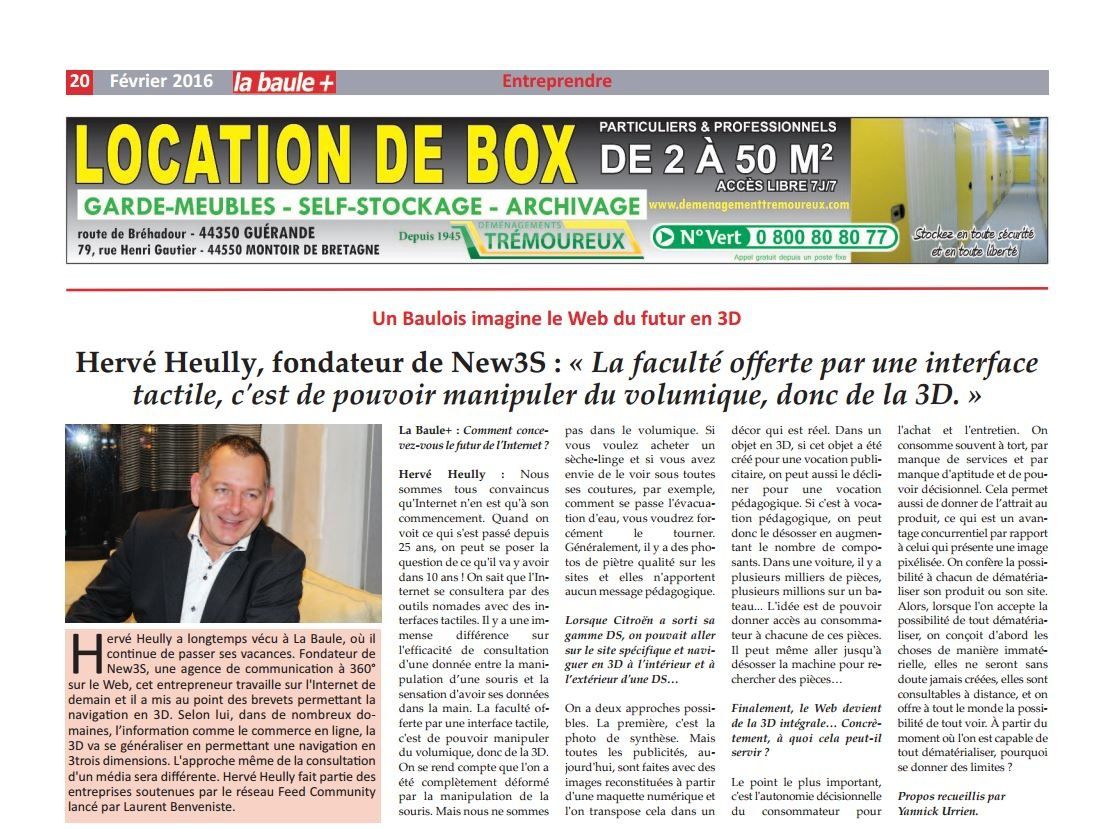The revolutionary new America's Cup AC75 revealed: from 2D to 3D - from virtual to real !
Publié le 10 Septembre 2018
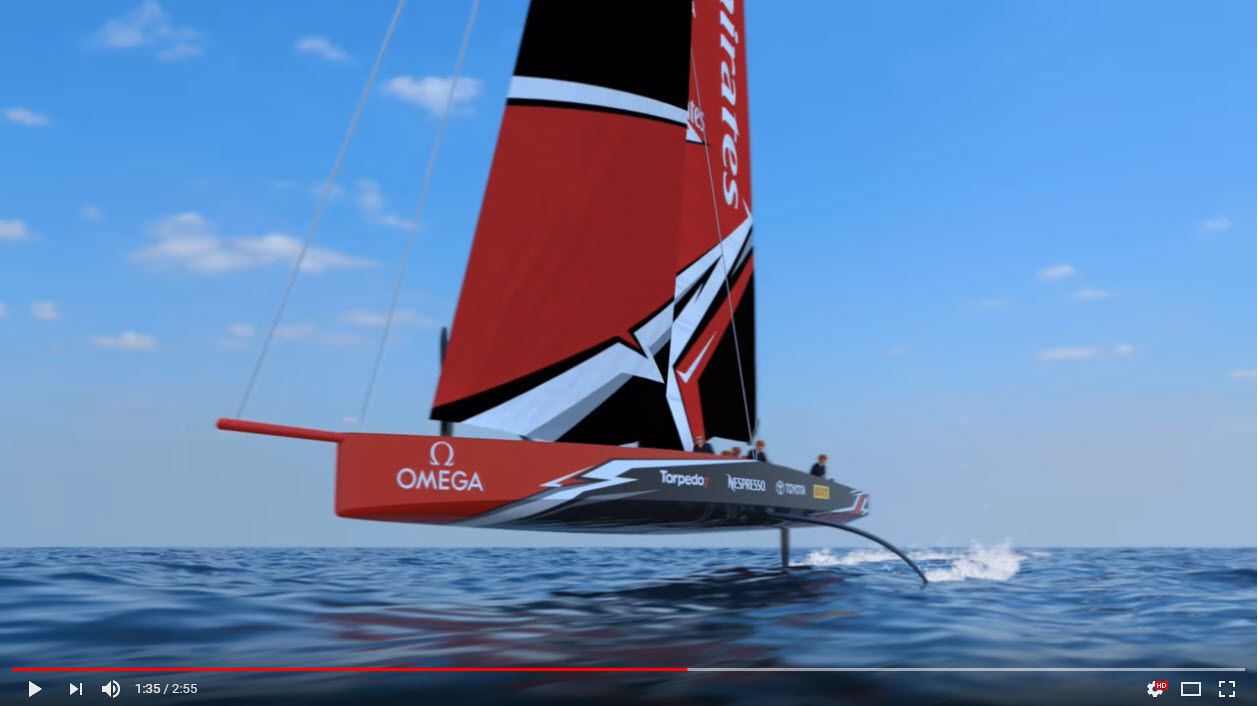
The revolutionary new America's Cup AC75 revealed
The concept of the revolutionary new AC75, the new foiling monohull class that will be raced in the 36th America's Cup in Auckland 2021. The innovation and design is unseen in sailing designed and developed by the America's Cup defender Emirates Team New Zealand and the Challenger of Record Luna Rossa
More and better quality images have emerged of the INEOS Team UK test boat - a hybrid of a QUANT 28 sports boat hull and fitted foils which mimic those to be used on an AC75 the foiling monohull to be used in the 36th America's Cup.
Update: Video of the modified QUANT28 foiling in the Solent on on of their first test sails. The video shows the foiling monohull concept to be stable in flight. It is not known whether the foiling is under manual or full computer control.
The concept of the foiling monohull appears to be less radical than early impressions. Providing the foiling geometry is correct there is no reason to believe that the AC75 would not perform as intended.
Certainly, the smaller QUANT 23 supplied as a foiler using daggerboards appears quite stable in flight mode.
The British team are the first to launch a prototype. Other teams are believed to have similar projects underway. However with the first permitted launch date for the first AC75 just over eight months away the imperative could be turning to getting a full-size AC75 launched and sailing - and using that for learning the characteristics of the new boat.
The QUANT 28 is a standard sports boat design offered by Swiss-based QUANT Boats, who work closely with British designer Hugh Welbourn. His QUANT 23 foiling design, using daggerboards lowered in the same style as the AC72 and AC50, is a standard package from QUANT.
No sails have been visible on any of the images of the INEOS Team UK test boat, and in previous images there are only two sailors on the boat. With tank testing being prohibited under the Protocol for the 36th America's Cup, it may well be that the 28ft prototype has been used only for towing tests to check foiling characteristics
Sail-World understands that all entered teams in the 36th America's Cup have been supplied with detailed designs of the foiling mechanism to be used to raise and lower the foil arms on the AC75 - even though this will be a supplied part for the Cup boats.
The shape and dimensions of the foils attached to the foil arm are free design - provided they fit within a specified outline which permits a variety of shapes and options.
The most interesting aspect of the INEOS Team UK test boat is the aircraft like wing shape - quite different from the wing shapes first seen on the L-shaped foils of the AC72, and the removable foil tips used on the AC50's in conjunction with two basic daggerboard stocks.
The trade-off with the AC75 is to have a hull that is the minimum drag at the lighter end of the wind range with foils that will start to lift the hull as soon as possible (which usually means having a larger foil). Then when in a wind strength that allows for foiling state to be achieved easily, the bigger high lift foils give way to a smaller foil that will still lift the main hull but will be faster because of its lower drag.
Even fitted with light air foils the AC50's were unable to sail below 90degrees to the true wind in less than 7kts of breeze, and understanding this limitation in the AC75 will be a key learning for the teams

In the AC75 there is a further trade-off between the foil sizes when tacking and gybing as to how long both foils need to be immersed providing the necessary lift and then transition to a single immersed foil - with the new windward foil in the canted position and using its approximately 1000kg of weight to provide increased righting moment and adding to boatspeed.
The ideal solution would be for a set of adjustable rake and retractable wings in the style of the F-111 swing-wing jet fighter to achieve the best lift/speed tradeoff. Whether this is possible and legal is an entirely different matter.
An issue with the 28ft prototype which is 10ft smaller than the allowed maximum size of 12metres overall (39ft 4in), is how well the 28ft boat will scale to the full 75ft race boat.
An obvious feature of the modified QUANT 28 is the "water wings" type flotation strapped under a frame - giving the boat stability at rest - and extreme heeling situations when under test towing/sailing. Hull design in the AC75 is open - apart from some restrictions on the forward hull sections to prevent the development of skimmers. The point being that the AC75 would be expected to have sufficient beam to be self supporting at rest, but will also be a hull shape that is trading off beam and hull volume against light air and pre-foiling drag.
The rule for the event only permits 25% of one AC75's hull surface area to be modified, providing limited scope for later design upgrades. That rule means that there is a strong incentive to get the first AC75's hull as close to being correct as possible, before launching the raceboat - if indeed the team opts to run a two boat campaign.
Emirates Team New Zealand are offering a basic sail-away AC75 design package which will reduce the design risk for new teams, and opening options with a maximum size surrogate boat and a single AC75 which can then have her hull surface modified 25% if required as permitted by the rules.
Another area of learning on the test boat - whatever size - will be the sailing of this type of foiling monohull, and whether there is any propensity to nosedive.
A key in that area of testing will be the announcement of the course locations by the Defender at the end of next month - which will then allow the teams to assess the likely sea state in which the AC75 design will be required to sail. The likely course area in the inner Hauraki Gulf will not be the flat water of the Great Sound in Bermuda which prevailed for the 35th America's Cup.
From that perspective the pendulum swings towards an early launch of an AC75 - as the foiling geometry will be accurate - as the AC75 is almost double the length of the longest allowed surrogate boat - and 2.6 times the length of the INEOS Team UK test boat.
read more : http://www.americascup.com/en/video/53_The-revolutionary-new-America-s-Cup-AC75-revealed
read more : https://www.sail-world.com/news/207932/Images-of-the-INEOS-Team-UK-test-boat
#americascup #INEOS #INEOSTEAMUK @EmiratesTeamNZ @lunarossa @NYYCAmericanMag #AC36 #RNZYS
That is quite a different situation from the 35th America's Cup where the reduction in length from the AC62 to an AC50 nine months after entries had closed meant that the allowed test boat hull length of 45ft was only 10% short of the race boat length of 50ft. Emirates Team New Zealand worked a loophole in that rule by using a one-metre long rudder foil gantry to stretch the 45fter to approximately 49ft - and effectively mimic the same foiling geometry of the AC50.
The rudder gantry allowed the distance between the daggerboard foils and rudder foils to be the same as the AC50, and the crossbeams were the same as the AC50 - so foiling length and beam was the same as the AC50. The shortfall in length came out of the bow of the test boat - irrelevant anyway as the test boat was foil-borne, and the normal speed deliminator of immersed waterline length, was irrelevant.
The lesson from the last America's Cup was that the team won, who launched late, had only one test boat, and spent their time and intellect developing sophisticated simulation systems which were accurately bench-marked with the race boat.
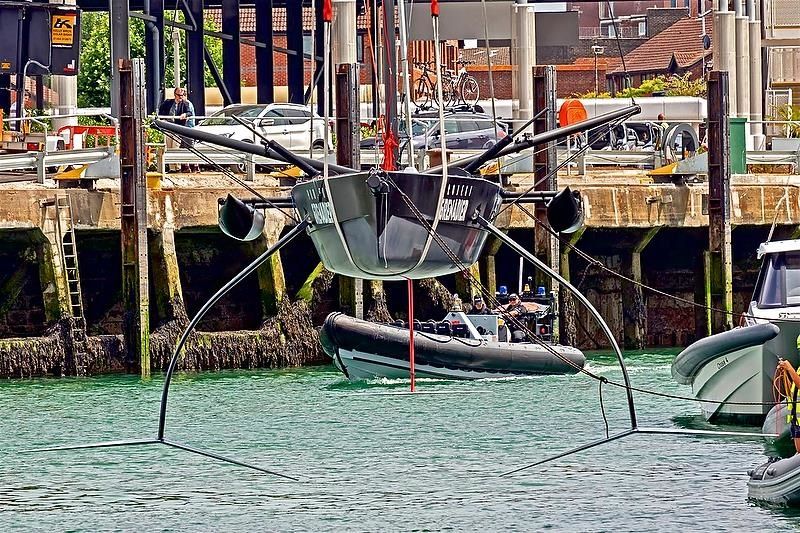
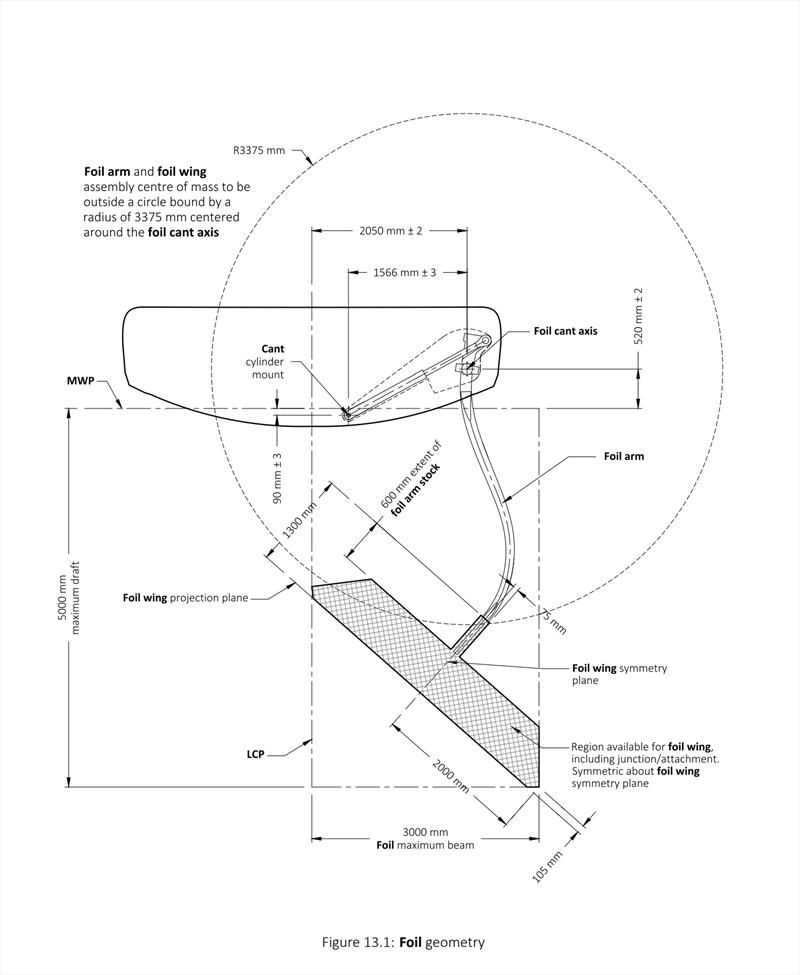

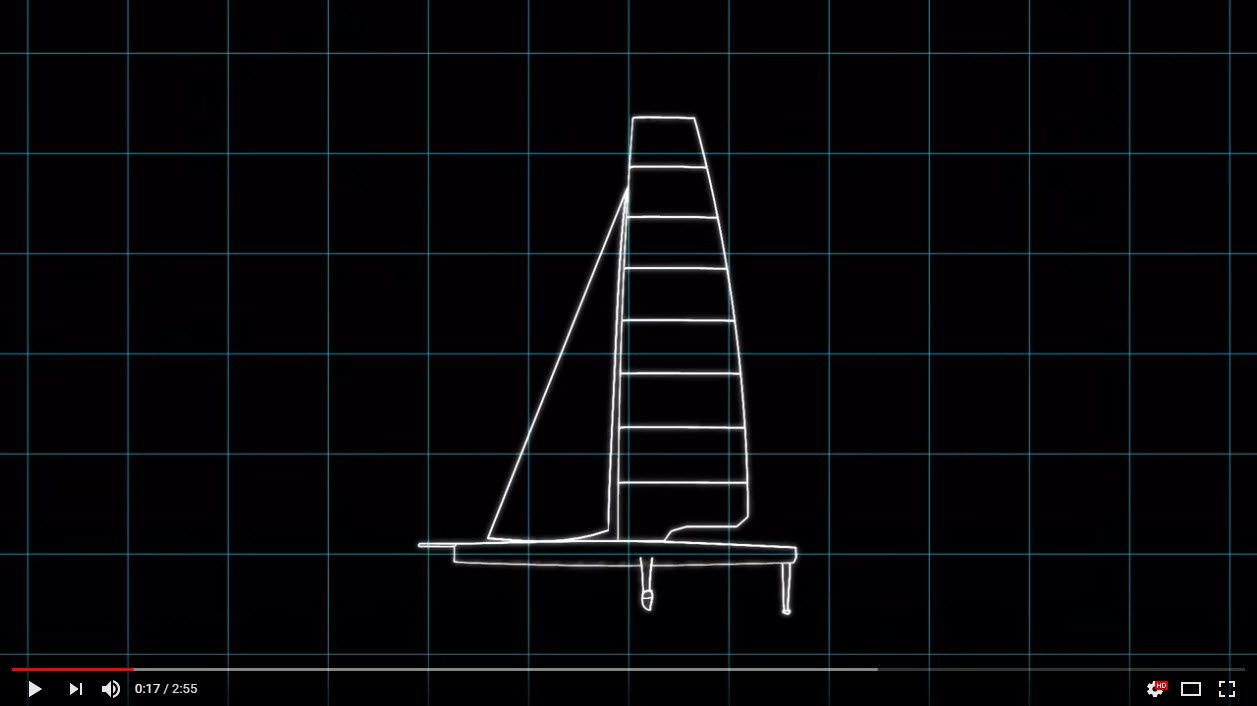

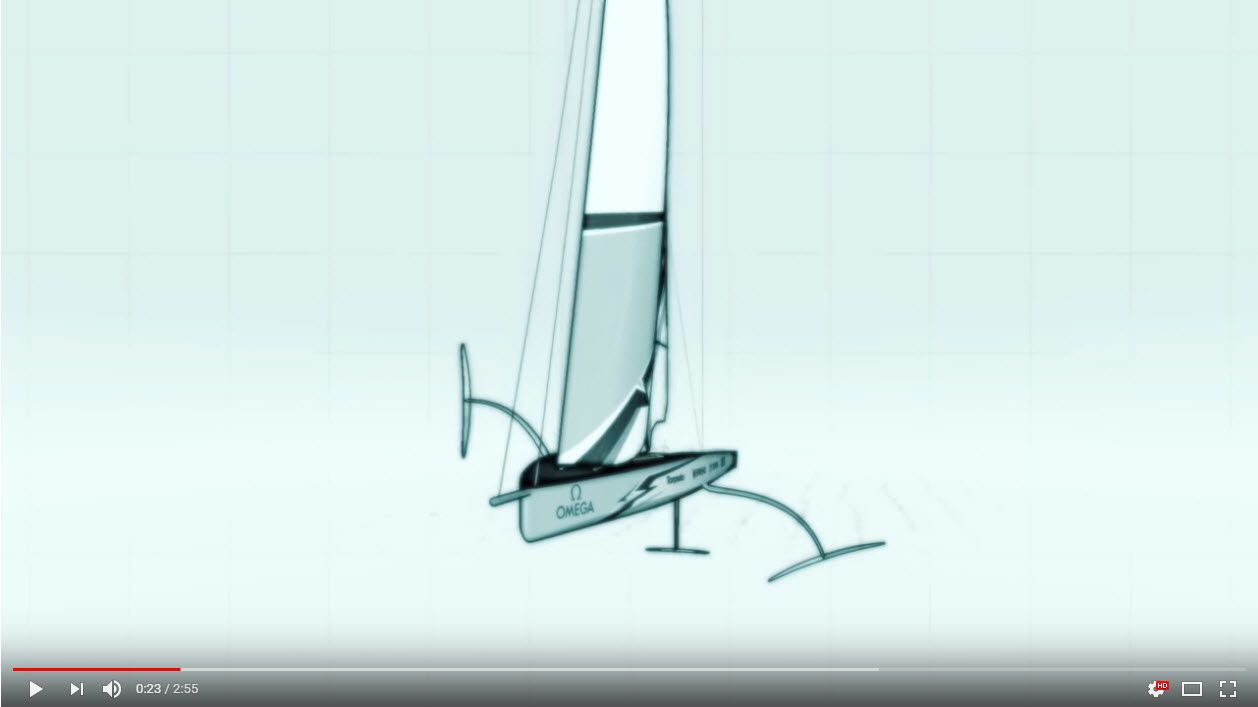


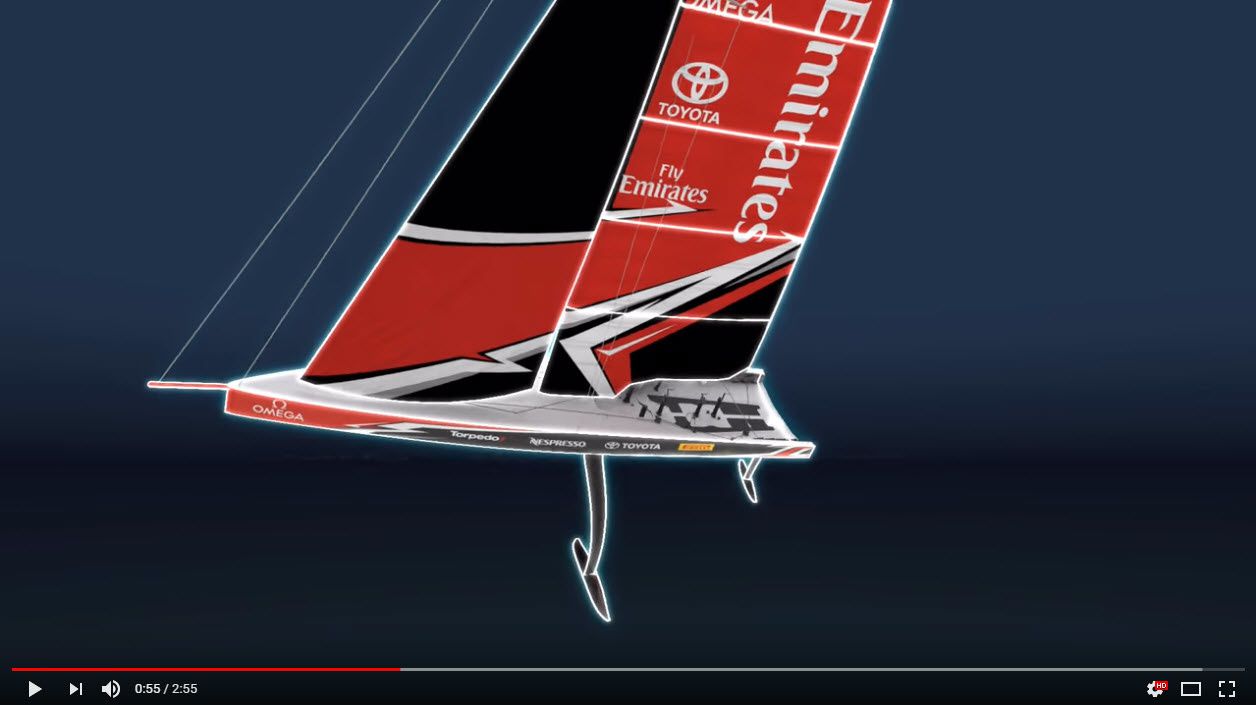
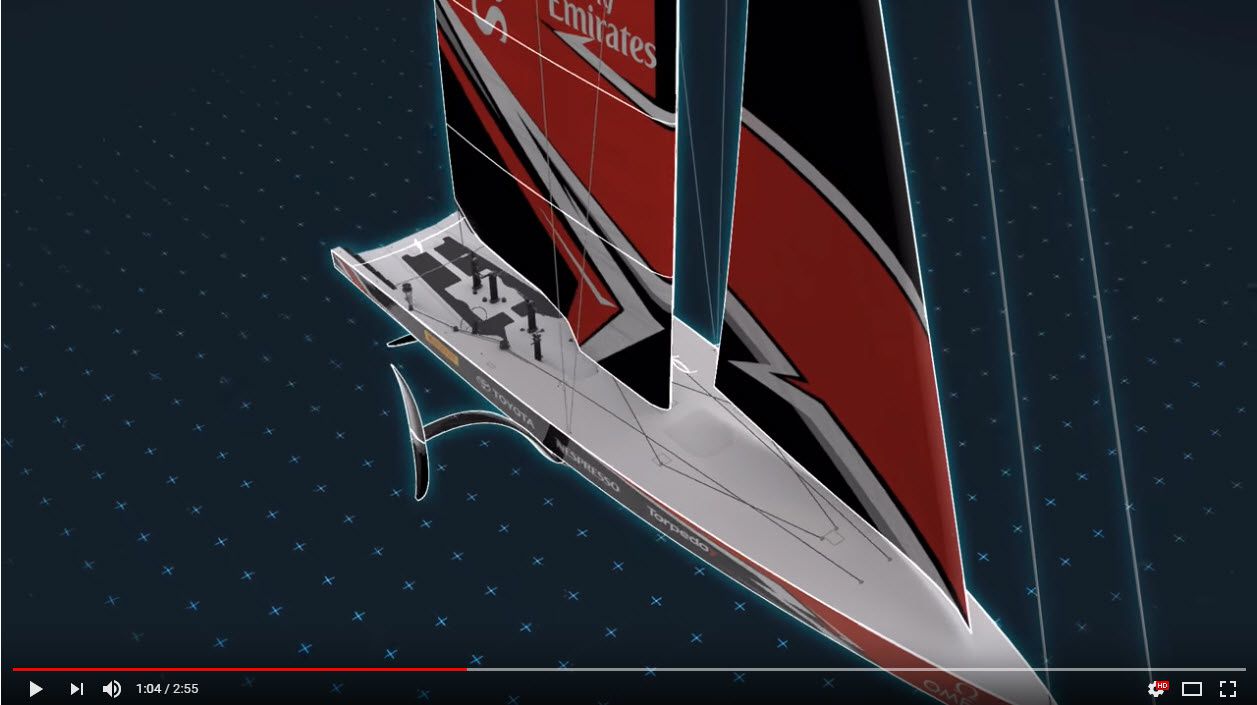
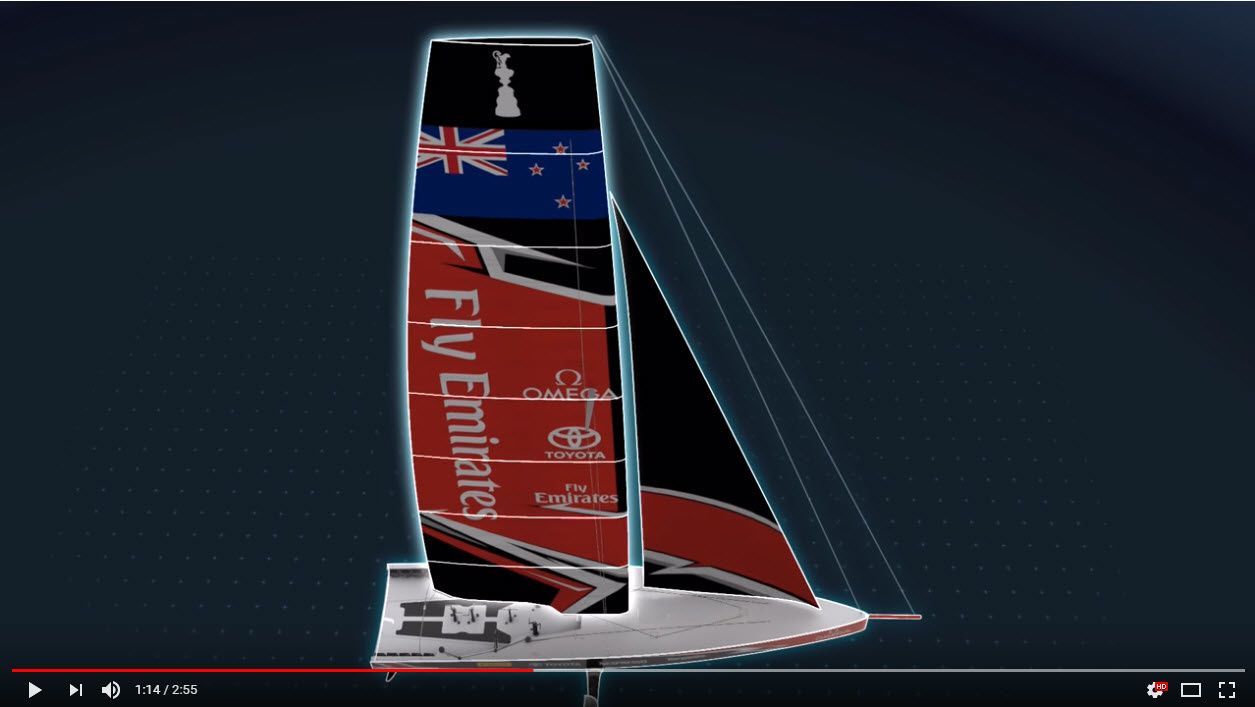
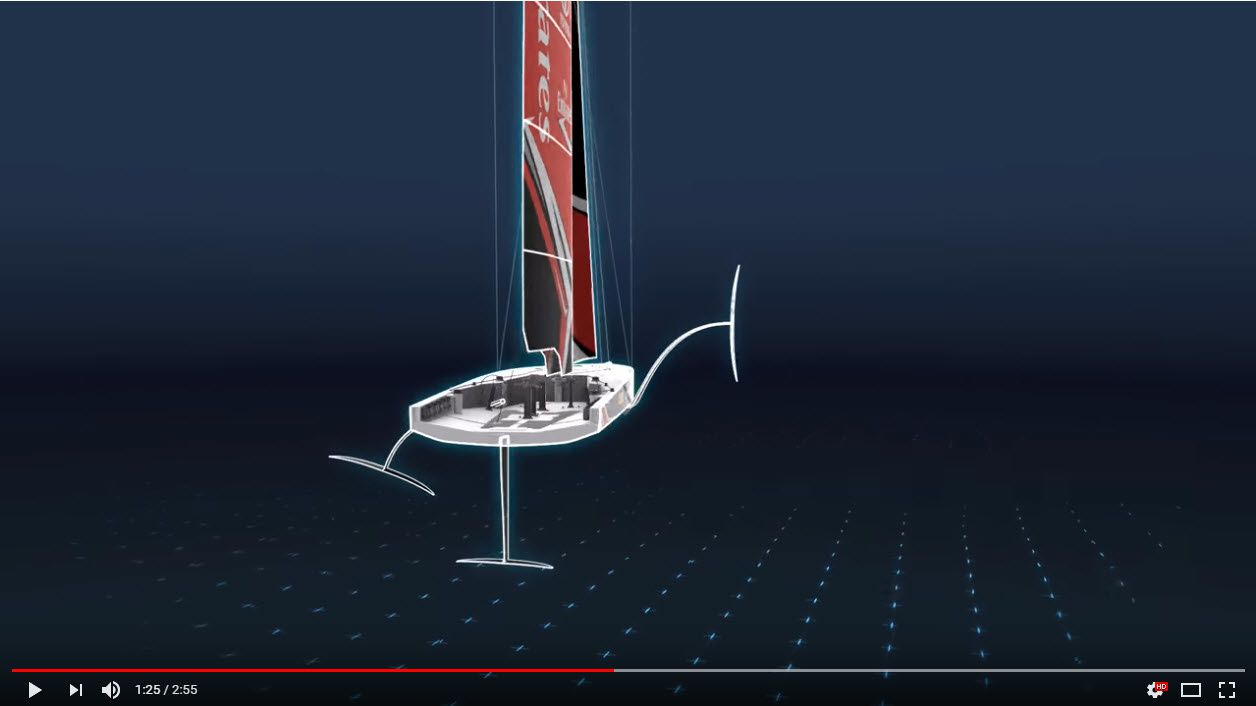

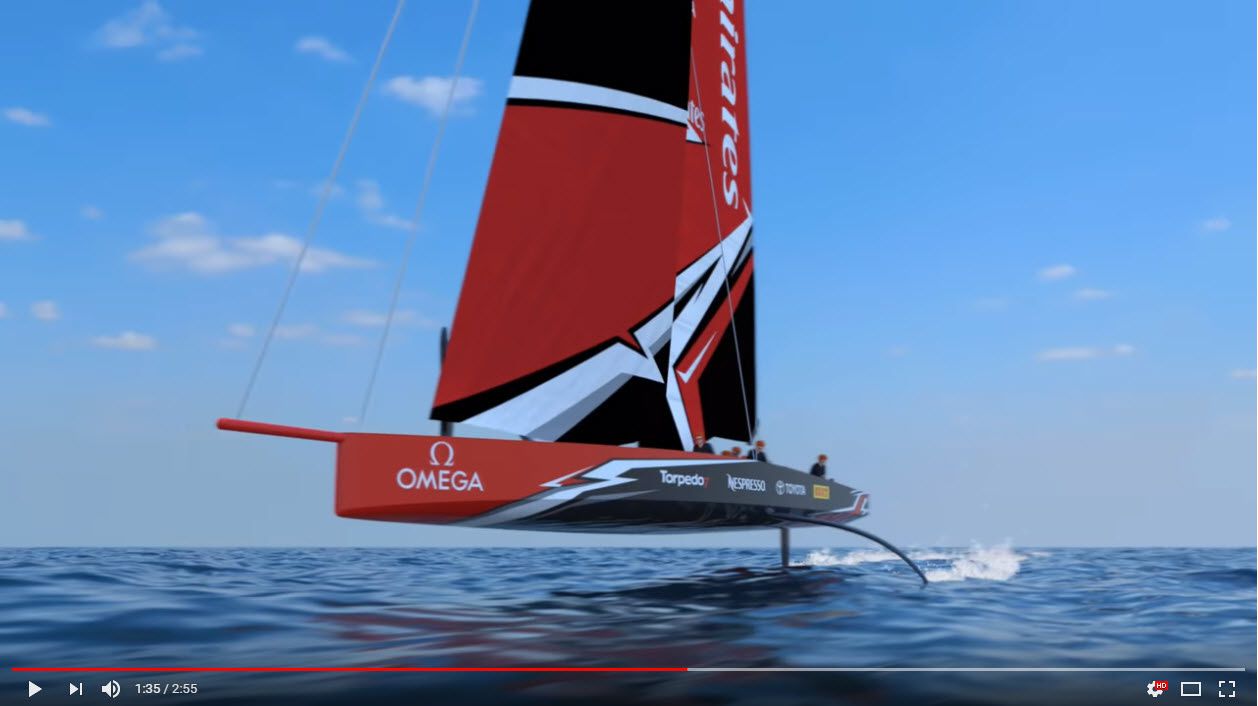
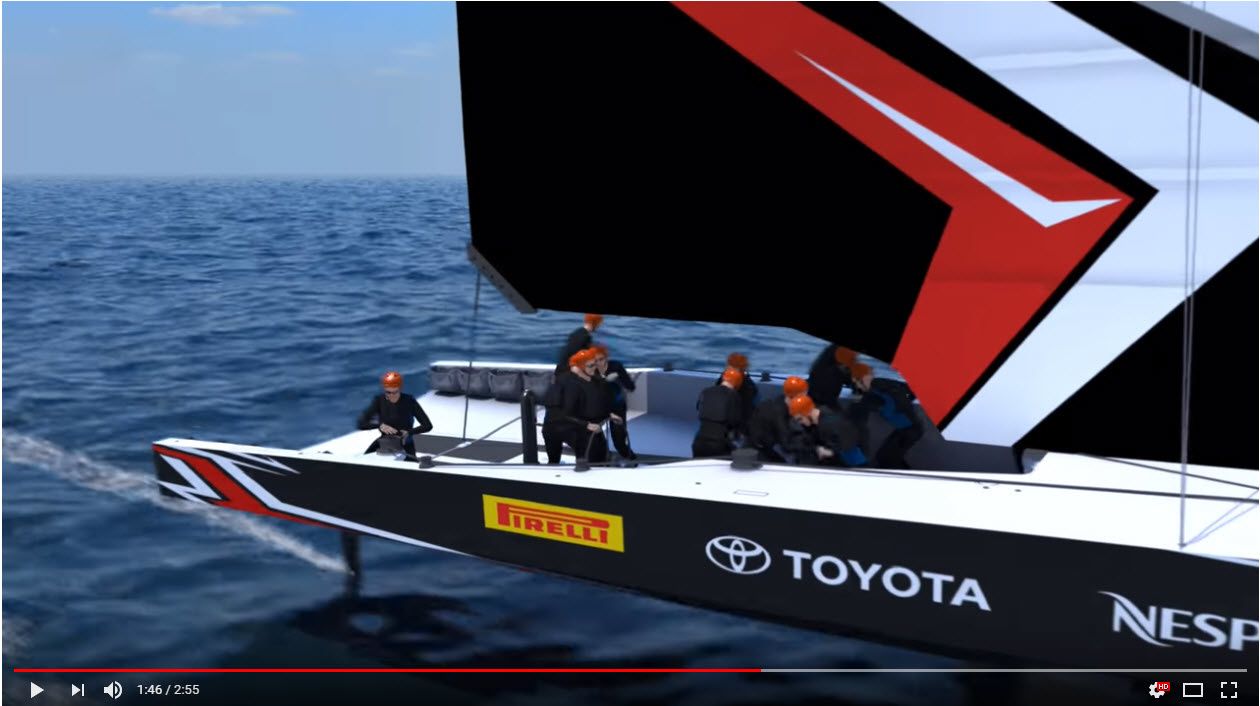
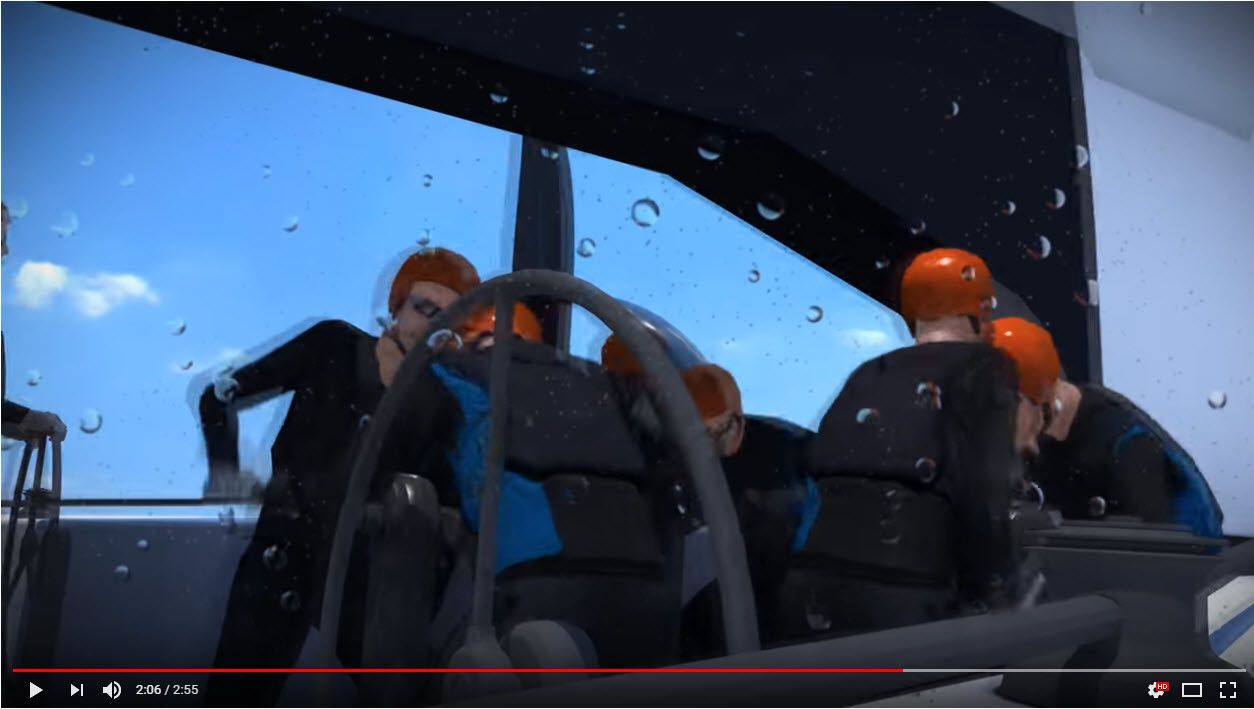

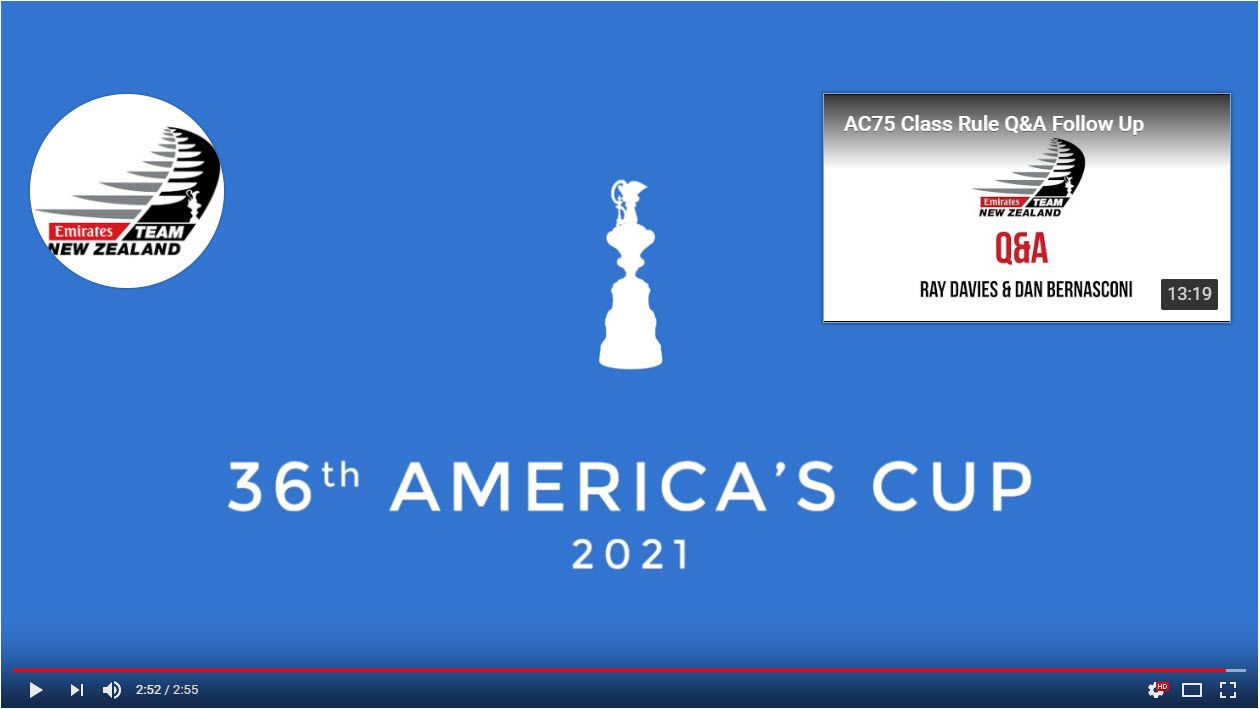
/image%2F0540585%2F20180909%2Fob_52174f_yysw220732.jpg)
Ahead of the America's Cup Overture to be staged at 1.00pm today in Cowes, IOW, the British Challenger INEOS Team UK have released a high definition video of their Surrogate test boat, a Quant 28 ...
Le Team INEOS UK de Ben Ainslie dévoile le T5, son bateau d'essai pour la 36ème Coupe de l'America - 3D SPORT CENTER
/image%2F0846185%2F20201105%2Fob_486e74_alex-thomson-alexthomsonracing-the-hub.jpg)
Vendee Globe 2020 : course mythique a la voile #000 Préparatifs - Zoom sur HUGO BOSS et Alex Thomson https://www.alexthomsonracing.com/the-hub Y a t il eu déjà dans l'Histoire de la Course au Large
Vendee Globe 2020 : course mythique a la voile #000 Préparatifs - Zoom sur HUGO BOSS et Alex Thomson - OOKAWA Corp. Raisonnements Explications Corrélations
Acte de Guerre dans l'économie Numérique par dépôt de brevet : savoir protéger le savoir(-faire) en contexte de Transformation Digitale
/image%2F0846185%2F20161106%2Fob_204c07_20160608175516-5june06.jpeg)
La possibilité d'utiliser une technologie tactile prenant en compte le degré de la pression exercée sur un écran va bientôt devenir la norme sur tous les terminaux mobiles. Les ingénieurs de ...
La 3D tactile sera bientot la norme sur tous les terminaux mobiles : la pression exercée pilote ... les interfaces - OOKAWA Corp.
/image%2F0846185%2F20180329%2Fob_e81928_ecran-samsung-incurve-1m20-long-ookawa.gif)
mise à jour 24/07/2018 Pourquoi & comment anticiper une nécessaire compétitivité mondiale pour 2020 et après. Hervé HEULLY Président fondateur de New3S retrace 15 ans de bonds technologiques...
Hervé HEULLY Président fondateur de New3S retrace 15 ans de BONDS TECHNOLOGIQUES ou pourquoi et comment anticiper une nécessaire compétitivité mondiale pour 2020 et après ! - OOKAWA Corp.
/image%2F0846185%2F20170617%2Fob_46183f_wow-35th-americas-cup-report-18-day-8.jpg)
World on Water's" 35th Americas Cup june 03 Report - OOKAWA Corp.
In Part 2 of the "World on Water's" 35th Americas Cup june 03 Report we say farewell to Franck Cammas and the Groupama Team France. Now the other four tea,s move on to find the eventual challenger ...
http://ookawa-corp.over-blog.com/2017/06/world-on-water-s-35th-americas-cup-june-03-report.html
World on Water's" 35th Americas Cup june 03 Report - OOKAWA Corp.
/image%2F0846185%2F20150829%2Fob_4ea99a_americas-cup-twitter.JPG)
Louis Vuitton America's Cup World Series Gothenburg Race Track ... 35th Americas Cup! - OOKAWA Corp.
Can't wait to watch race L'ultime en matière de sport, de technologie, de relation humaine ! Watch Louis Vuitton America's Cup World Series Gothenburg Race Track The Louis Vuitton America's Cup ...
Louis Vuitton America's Cup World Series Gothenburg Race Track ... 35th Americas Cup! - OOKAWA Corp.
/image%2F0846185%2F20160105%2Fob_02ebc3_2c9e9a2500000578-3243137-image-m-3-144.jpg)
World Largest Sailing Yacht "A" Superyacht grande yate grand voilier - OOKAWA Corp.
Rich people have no taste when it comes to yacht design .. that's the ugliest thing I have ever seen on water That's what you call an upgrade! Russian billionaire unveils his £260m superyacht w...
World Largest Sailing Yacht "A" Superyacht grande yate grand voilier - OOKAWA Corp.
/image%2F0846185%2F20161114%2Fob_b62aca_keel-walk-alex-thomson-hugo-boss-ookaw.jpg)
Le Marketing des marques par ... l'image spectaculaire : le cas HUGO BOSS et Alex THOMSON avec le KEEL WALK A daring seaman proves he has a licence to keel. Looking every part the classic James ...
Le Marketing des marques par ... l'image spectaculaire : le cas HUGO BOSS et Alex THOMSON avec le KEEL WALK - OOKAWA Corp.
/image%2F0846185%2F20150830%2Fob_301cf6_m829-crop169014-1024x576-proportional.jpg)
Pas de Live sur l'Apps AC+ en FRANCE, malgré la participation de GROUPAMA Team - OOKAWA Corp.
France , Monaco, Andorra, French-speaking Switzerland, Mauritius, DOMTOM and sub-Saharan Africa (not South Africa): Live for both days on Canal+ Décalé: 1100 - 1230 GMT. Repeat on Canal+ Sport ...
Pas de Live sur l'Apps AC+ en FRANCE, malgré la participation de GROUPAMA Team - OOKAWA Corp.
/image%2F0846185%2F20161111%2Fob_f59436_foils-moustaches-font-voler-bateau-ook.jpg)
IMOCA à foils : Les foils, des moustaches qui font voler les bateaux ... - OOKAWA Corp.
virtuellement qu'on fasse que note bateau pèse moins lourd ... IMOCA à foils : Les foils, des moustaches qui font voler les bateaux ... Sites webs/blogs, copiez cette vidéo avec le bouton "Inté...
IMOCA à foils : Les foils, des moustaches qui font voler les bateaux ... - OOKAWA Corp.
/image%2F0846185%2F20170119%2Fob_09793f_arrivee-armel-le-cleach-vendee-globe-2.jpg)
VENDEE GLOBE 2016 - 2017 : arrivée en leader d'Armel Le CLEAC'H sur Banque Populaire VIII ce 19/01/2017 aux Sables d'Olonnes Vendée Retransmission en LIVE sur internet et sur les Réseaux Sociaux Si
VENDEE GLOBE 2016 - 2017 : arrivée en leader d'Armel Le CLEAC'H sur Banque Populaire VIII ce 19/01/2017 aux Sables d'Olonnes Vendée - OOKAWA Corp.
/image%2F0846185%2F20160515%2Fob_e09620_chantier-saint-nazaire.JPG)
RCCI Royal Caribbean International : 'Harmony Of the seas' leaving to Southampton - OOKAWA Corp.
Royal Caribbean International :Undoubtedly, Cruise Specialists' most popular cruise line, Royal Caribbean International lets you explore the world like never before. The unscripted atmosphere ...
RCCI Royal Caribbean International : 'Harmony Of the seas' leaving to Southampton - OOKAWA Corp.
/image%2F0846185%2F20160329%2Fob_848edd_dji-phantom-4-french-rivierav.JPG)
Flyboard : Sport nautique avec Jet Ski Gopro - Drone - TV - OOKAWA Corp.
L'équipe de Flycaptain, les pros du flyboard, a publié une vidéo impressionnante réalisée à Théoules-sur-Mer. source : ...
http://ookawa-corp.over-blog.com/2016/03/flyboard-sport-nautique-avec-jet-ski-gopro-drone-tv.html
Flyboard : Sport nautique avec Jet Ski Gopro - Drone - TV - OOKAWA Corp.
/image%2F0846185%2F20161015%2Fob_86ddec_actu-6737-image2012rectangle-petite.jpg)
Le sport définitivement dopé à la data - Dare to be better ? OK ! - OOKAWA Corp.
Beaucoup sont conscients que la data est dans l'air du temps, mais ils ne sont pas encore tous prêts faute de moyens ou d'expertises. Ils doivent se former et prévoir d'engager un data scientist La
http://ookawa-corp.over-blog.com/2016/10/le-sport-definitivement-dope-a-la-data.html
Le sport définitivement dopé à la data - Dare to be better ? OK ! - OOKAWA Corp.
/image%2F0846185%2F20180605%2Fob_ee0bc1_facebook-surround-360-x24-x6.jpg)
Oculus and Facebook detail Red volumetric VR camera with Surround 360 Facebook Surround 360 (2017) x24 (left) and x6 (right) A camera capable of capturing volumetric video that can be explored with
Oculus and Facebook detail Red volumetric VR camera with Surround 360 : to go beyond a traditional 2D video recording - OOKAWA Corp.
/image%2F0846185%2F20191025%2Fob_db9e1c_course-mythique-voile-hugo-boss-imoca.jpg)
24h à bord de l'IMOCA Charal Course mythique à la voile : avec ou sans IMOCA 60 ? Le Vendée Globe est une course à la voile, autour du monde, en solitaire, sans escale et sans assistance, sur d...
Course mythique à la voile : Le Vendee Globe et les Sables-d'Olonne avec ou sans IMOCA 60 ? - OOKAWA Corp.

/image%2F0846185%2F20181026%2Fob_f5ea65_logo-export-new3s9-quart.jpg)
/http%3A%2F%2Fassets.over-blog.com%2Ft%2Ftwentyeleven%2Fimages%2Fpine-cone.jpg)

